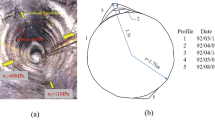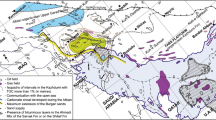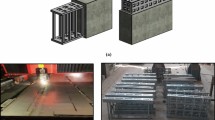Abstract
In hydraulic fracturing for fractured wells, the pressure of cyclic loading and unloading in the casing can easily lead to integrity failure of the cement sheath in the fracturing section, representing a production safety hazard. The integrity failure evaluation experiments of cement sheath were carried out for fractured wells under the condition of alternating loading. The cause of integrity failure was analyzed based on the fatigue cumulative damage theory and failure criteria. The integrity failure law was obtained for cement sheath under a confining pressure of 30 MPa and alternating loading. The results demonstrate the following findings: firstly, under alternating pressure, the internal structure of the cement is damaged, and its mechanical properties (such as compressive strength) decrease with increases in the number of alternating pressure cycles; the maximum decrease can be 40%. Secondly, the bond strength of the casing–cement interface is low, concentrated between 0.45 and 0.65 MPa, and the plastic accumulation of the cement sheath during fracturing leads to inconsistency in the interface strain between the casing and the sheath. The interface separates and forms a micro-annulus when the interfacial tensile stress exceeds the interfacial bond strength during pressure relief. Thirdly, under the condition of a confining pressure 30 MPa and high alternating pressure, micro-annulus formation is the primary mode of failure regarding cement sheath integrity. Increasing the elasticity and deformation ability of the cement sheath helps prevent this failure. The conclusions of this research may provide a technical reference for improving the cement slurry and fracturing operation of fractured wells and help ensure the integrity of the cement sheaths of fractured wells.















Similar content being viewed by others

References
Bu Y, Tian L, Guo B, Wang C, Sun B (2020) Experiment and simulation on the integrity of cement sheath interface in deepwater shallow formation. J Petrol Sci Eng 190:107127
Dai C (2017) Research on damage mechanism of cement sheath in hydraulic fracturing process: [D]. China University of Petroleum, Beijing
Deng K, Yue Y, Yi H, Li Z, Lin Y (2020) Experimental study on the integrity of casing-cement sheath in shale gas wells under pressure and temperature cycle loading. J Petrol Sci Eng 195:107548
Du J (2017) Research and application of mechanical integrity evaluation device for cementing cement sheath: [D]. Southwest Petroleum University
Eissa K, Ahmad R, Mehdi N (2021) Numerical modeling of oil well integrity with a particular view to cement (case study: Maroon oil field in southwest of Iran). J Petrol Sci Eng 196:107991
Fan M (2018) Research on the casing deformation and failure mechanism of cement sheath in shale gas wells: [D]. China University of Petroleum, Beijing
Fan M, Li S, Li J, Zhao C, Ma X, Gao H (2019) A new mechanical model for overburden fracture wellbore assembly of shale gas. Petroleum Machinery 47(07):63–70
Gao Y, Hu F, Han Q, Liu B, Zhou C (2014) Influence of mechanical properties of cement stone on wellbore seal integrity. Drill Fluid Completion Fluid 31(03):53-56 + 99
Gheibi S, Agofack N, Sangesland S (2021) Modified discrete element method (MDEM) as a numerical tool for cement sheath integrity in wells. J Petrol Sci Eng 196:107720
Harshkumar P, Saeed S (2021) The structural integrity of liner cement in oil & gas wells: parametric study, sensitivity analysis, and risk assessment. Eng Fail Anal 122:105203
Jiang G, Sun J, He Y, Cui K, Dong T, Yang L, Yang X, Wang X (2021) Novel waterbased drilling and completion fluid technology to improve wellbore quality during drilling and protect unconventional reservoirs. Engineering. https://doi.org/10.1016/j.eng.2021.11.014
Li Q, Lian W, Yan P, Meng Y, Wu L (2020) Research on the influence of thermal alternating cycle on dynamic elastic parameters of cement. Drill Prod Technol 43(03):7-9 + 1
Lin Y, Deng K, Yi H, Zeng D, Tang L, Wei Q (2020a) Integrity tests of cement sheath for shale gas wells under intense alternating thermal loads. Nat Gas Ind B 7(6):671–679
Lin Y, Deng K, Yi H, Zeng D, Tang L, Wei Q (2020b) Testing of cement sheath integrity of shale gas wells under strong alternating thermal loads. Nat Gas Ind 40(5):81–88
Meng M, Frash L, Carey JW, Niu Z, Zhang W, Guy N, Lei Z, Li W, Nathan, W (2021) Predicting Cement-Sheath Integrity with Consideration of Initial State of Stress and Thermoporoelastic Effects. SPE J 26:3505–3528. https://doi.org/10.2118/205344-PA
Ouyang Y, Gao Y, Wang X, Duan Z (2018) Stress analysis of the integrity of casing-cement sheath-structural consolidation body by volume fracturing. Adv Petroleum Explor Dev 15(1):64–71
Shen X, Wang X (2014) 3D numerical simulation on the failure of cement sheath of Macondo Well-# 1 in Deep Water Gulf of Mexico. Adv Mater Res 1044–1045:197–204
Wang B (2015) Analysis on integrity law of cement sheath structure under non-uniform in-situ stress: [D]. Northeast Petroleum University
Wang K (2018) Research on mechanical properties of cement sheath under fracturing condition of shale gas horizontal well: [D]. China University of Petroleum, Beijing
Wang Y, Gao D, Fang J (2020) Research on mechanical properties evaluation of cement sheath in shale gas horizontal well fracturing process. Oil Tubing Instruments 6(04):51–55
Xi Y, Wang H, Li J, Wang J, Wu H (2014) Experimental and numerical study on the influence of cyclic loading on the sealing property of cement sheath. China Petroleum Machinery 9(3):88–93
Xi Y, Li J, Liu G, Tao Q, Lian W (2018) A new numerical investigation of cement sheath integrity during multistage hydraulic fracturing shale gas wells. J Nat Gas Sci Eng 49:331–341
Xi Y, Li J, Tao Q, Zeng X, Zhong W (2020) Formation and evolution of microannulus under cyclic loading. Fault-Block Oil Gas Field 27(04):522–527
Funding
This work was supported by grants from the Scientific Research Project of the Hubei Provincial Department of Education (D20201304).
Author information
Authors and Affiliations
Contributions
S. Z. was in charge of the theoretical modeling and carrying out the experiments. L. C. was in charge of analyzing data, writing, and polishing the paper.
Corresponding author
Ethics declarations
Conflict of interest
The authors declare no competing interests.
Additional information
Responsible Editor: Santanu Banerjee
Rights and permissions
About this article
Cite this article
Zheng, S., Cheng, L. Integrity evaluation method for cement sheath of hydraulic fracturing wells. Arab J Geosci 15, 1283 (2022). https://doi.org/10.1007/s12517-022-10576-7
Received:
Accepted:
Published:
DOI: https://doi.org/10.1007/s12517-022-10576-7



